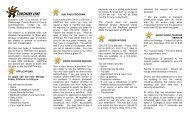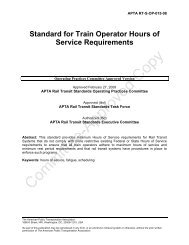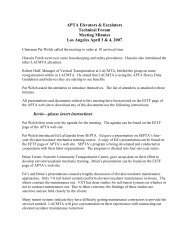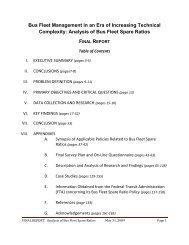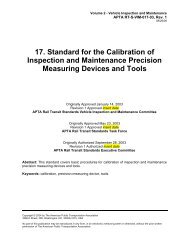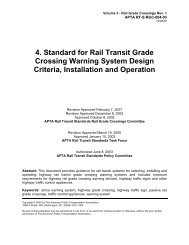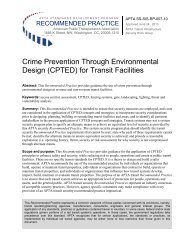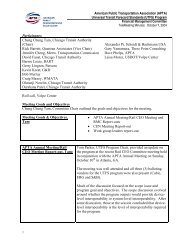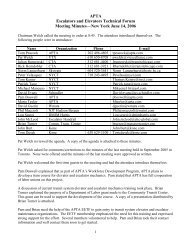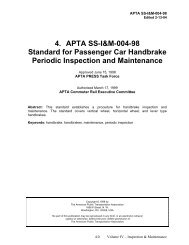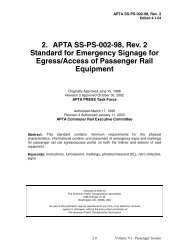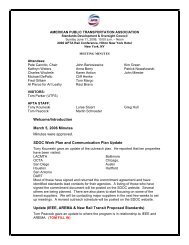Standard Bus Procurement Guidelines - APTAStandards.com
Standard Bus Procurement Guidelines - APTAStandards.com
Standard Bus Procurement Guidelines - APTAStandards.com
Create successful ePaper yourself
Turn your PDF publications into a flip-book with our unique Google optimized e-Paper software.
<strong>Standard</strong> <strong>Bus</strong> <strong>Procurement</strong> <strong>Guidelines</strong><br />
Splash aprons, <strong>com</strong>posed of 1/4-inch-minimum <strong>com</strong>position or rubberized fabric, shall be installed<br />
behind each wheel and shall extend downward to within 3 inches of the road surface. Apron widths<br />
shall be no less than tire widths, except for the front apron which shall extend across the width of the<br />
bus. Splash aprons shall be bolted to the bus understructure. Splash aprons and their attachments shall<br />
be inherently weaker than the structure to which they are attached. The flexible portions of the splash<br />
aprons and their attachments shall not be included in the road clearance measurements. Other splash<br />
aprons shall be installed where necessary to protect bus equipment.<br />
5.4.3.8 SERVICE COMPARTMENTS AND ACCESS DOORS<br />
5.4.3.8.1 Access Doors<br />
Conventional or pantograph hinged doors shall be used for the engine <strong>com</strong>partment and for all auxiliary<br />
equipment <strong>com</strong>partments including doors for checking the quantity and adding to the engine coolant,<br />
engine lubricant and transmission fluid. Access openings shall be sized for easy performance of tasks<br />
within the <strong>com</strong>partment including tool operating space. Access doors shall be of rugged construction<br />
and shall maintain mechanical integrity and function under normal operations throughout the service<br />
life of the bus. They shall close flush with the body surface. All doors shall be hinged at the top or on<br />
the forward edge and shall be prevented from <strong>com</strong>ing loose or opening during transit service or in bus<br />
washing operations. Doors with top hinges shall have safety props stored behind the door or on the<br />
doorframe. All access doors shall be retained in the open position by props or counterbalancing with<br />
over-center or gas-filled springs and shall be easily operable by one person. Springs and hinges shall be<br />
corrosion resistant. Latch handles shall be flush with, or recessed behind, the body contour and shall be<br />
sized to provide an adequate grip for opening. Access doors, when opened, shall not restrict access for<br />
servicing other <strong>com</strong>ponents or systems.<br />
Baseline: Requirement for locks on access<br />
doors. Also see Section 5.4.4.8.<br />
Access doors larger in area than 100 square<br />
inches shall be equipped with locks. The locks<br />
shall be standardized as defined by the<br />
Procuring Agency in the attachments to Part 5:<br />
Technical Specifications so that only one tool<br />
is required to open all major access doors on<br />
the bus.<br />
Alternative: Deletion of the requirement for<br />
locking access doors. Also see Section 5.4.4.8.<br />
Access doors larger in area than 100 square<br />
inches shall be equipped with latches. The<br />
latches shall be standardized and shall be<br />
openable without the use of a key or tool.<br />
The battery <strong>com</strong>partment or enclosure shall be vented and self-draining. It shall be accessible only<br />
from outside the bus. All <strong>com</strong>ponents within the battery <strong>com</strong>partment, and the <strong>com</strong>partment itself,<br />
shall be protected from damage or corrosion from the electrolyte and gases emitted by the battery. The<br />
inside surface of the battery <strong>com</strong>partment's access door shall be electrically insulated, as required, to<br />
prevent the battery terminals from shorting on the door if the door is damaged in an accident or if a<br />
battery <strong>com</strong>es loose. The Master Battery Switch accessibility requirements are defined in Section 5.5.8<br />
of Part 5: Technical Specifications.<br />
5.4.3.8.2 Service Area Lighting<br />
Technical Specifications 153 10/18/07



